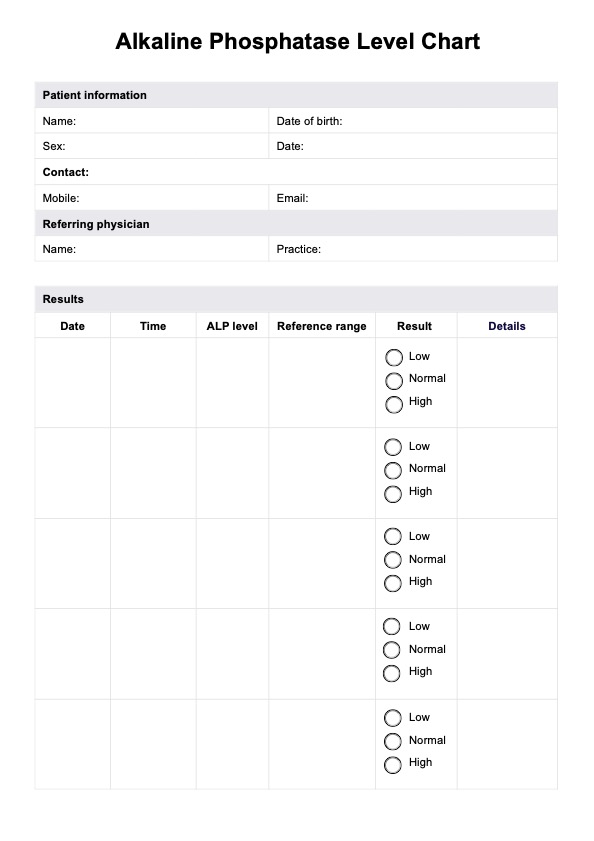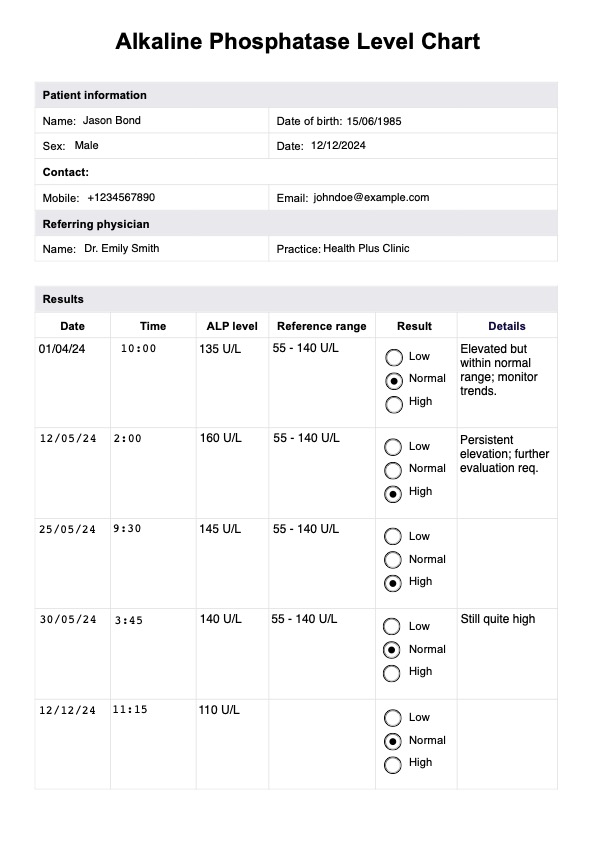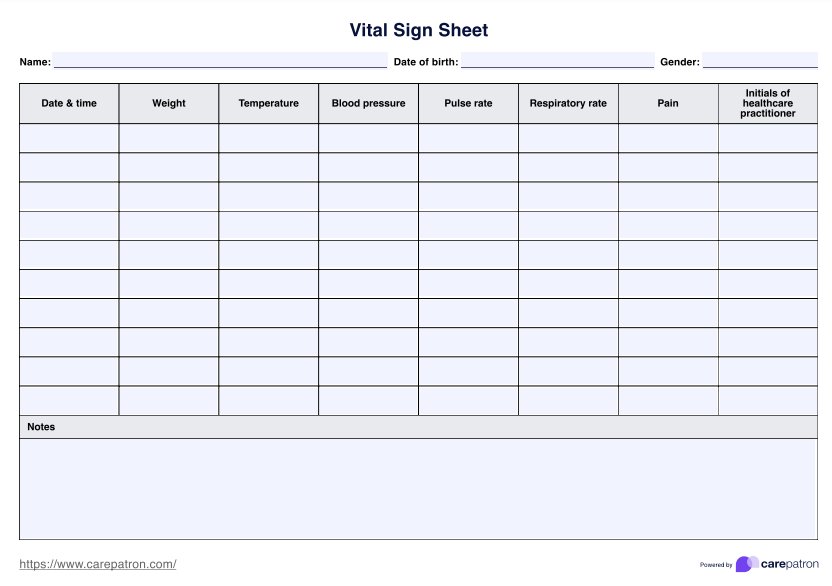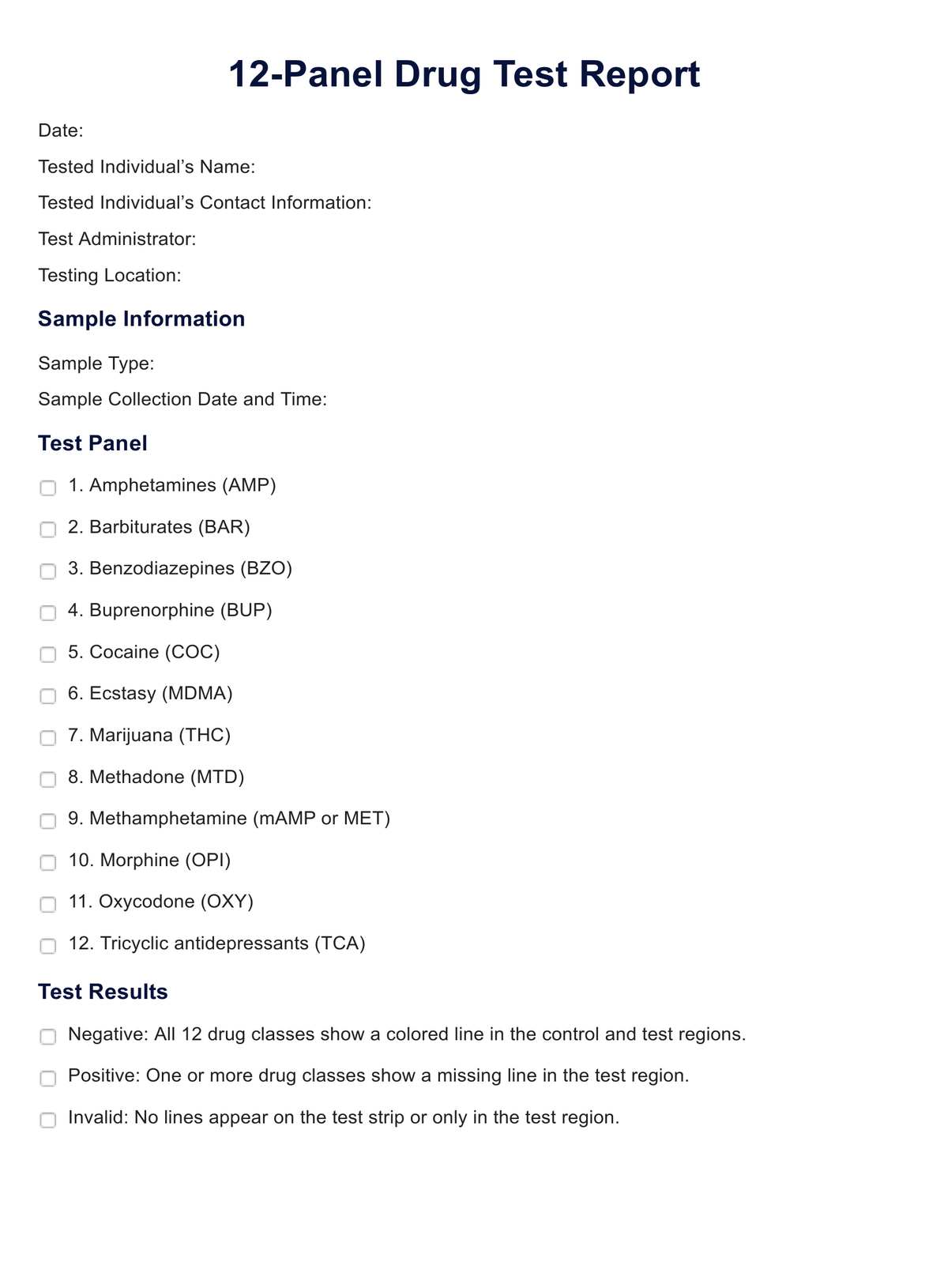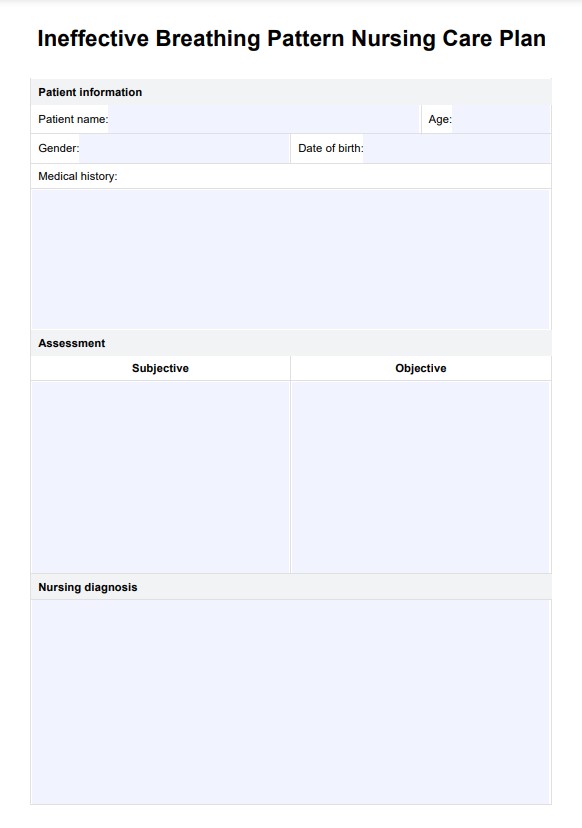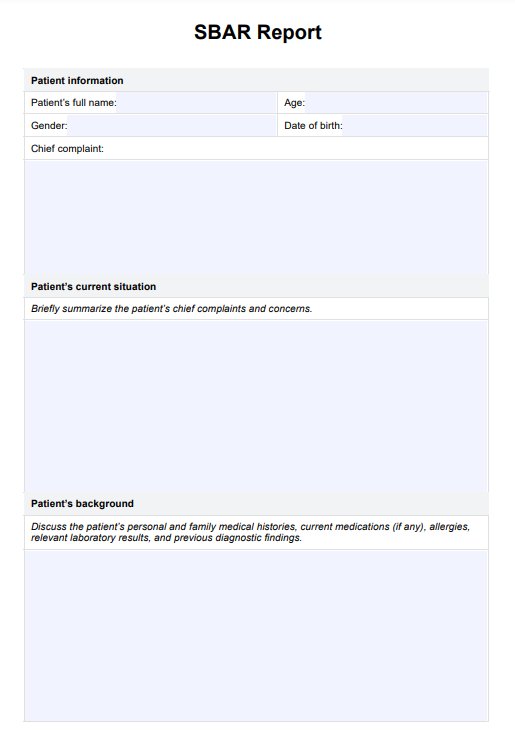Alkaline Phosphatase Level
Download our Alkaline Phosphatase (ALP) Level Chart to document and track your patients' ALP levels effectively.


What is an Alkaline Phosphatase (ALP) Level Chart?
An Alkaline Phosphatase (ALP) Level Chart is a valuable tool for recording and interpreting ALP enzyme levels in the bloodstream, which are reflective of various physiological and pathological states. ALP, an enzyme in tissues like the liver, bones, kidneys, and digestive system, plays a significant role in metabolic processes. Abnormal variations in ALP levels can indicate liver diseases, bone disorders, and, in some cases, rare conditions like hypophosphatasia. The chart offers a systematic framework for documenting these levels, utilizing sex- and age-specific reference intervals to enhance diagnostic accuracy and inform treatment decisions.
The advancement of population-derived reference intervals has marked a significant step forward in clinical practice. These updated intervals help minimize unnecessary testing, often incurring additional costs and patient discomfort. Furthermore, including well-defined lower reference limits ensures that conditions like hypophosphatasia, associated with low ALP levels, are promptly identified and addressed (Joseph & Hashim, 2024). By integrating these refined intervals into the ALP Level Charts, clinicians can make more precise assessments, facilitating better patient care tailored to individual needs.
To support this effort, we have designed an ALP Level Chart incorporating these advancements to provide a comprehensive and user-friendly tool for healthcare professionals and patients. By integrating reference intervals and documentation features, it serves as a robust resource for improving the quality of care and ensuring patient-centric outcomes.
Alkaline Phosphatase Level Template
Alkaline Phosphatase Level Example
How to use our Alkaline Phosphatase Level Chart?
Our ALP Level Chart is an all-in-one template that includes fields for patient information, alkaline phosphatase test results, and reference intervals for accurate diagnosis and monitoring. The reference values are based on Joseph and Hashim's (2024) recent patient-derived reference intervals of ALP. Follow these steps to integrate it into your practice:
Step 1: Access the ALP Level Chart
You can easily obtain the chart by clicking the “Download” or “Use template” buttons in this guide. It is also available in Carepatron’s template library, accessible through the website or app for added convenience.
Step 2: Fill in patient information
Start by entering all necessary patient details, including the patient's name, date of birth, age, gender, and the attending physician's name. Accurate information ensures the chart is personalized and serves as a comprehensive medical record.
Step 3: Record ALP test results
Use the designated sections to document the patient's ALP levels, along with the date and time of the test. Include the reference ranges for the patient's age and sex to facilitate comparison with the recorded values. This allows for a quick assessment of whether the ALP level is within normal limits.
Step 4: Interpret and document findings
The chart includes areas to note whether the recorded ALP levels are low, normal, or high. Utilize the notes section to document clinical observations, interpretations, and recommended actions, such as follow-up tests or interventions. This ensures the chart is both diagnostic and action-oriented.
Step 5: Store the completed chart securely
After completing the chart, store it securely to maintain confidentiality. If you’re using Carepatron’s digital platform, leverage the HIPAA-compliant storage system for secure, organized record-keeping. This ensures the chart is accessible only to authorized personnel while protecting patient privacy.
Benefits of using our ALP Level Chart
Here are some of the benefits of using our free template:
User-friendly and accessible
The ALP Level Chart is designed to be simple and intuitive, making it easy for healthcare professionals across various specialties to use. It is readily accessible through Carepatron’s platform in print and digital formats. The chart’s user-friendly layout streamlines documenting ALP levels, ensuring clinicians can focus on providing effective patient care.
Comprehensive and accurate documentation
The chart supports precise documentation of ALP levels, integrating updated age and sex-specific reference intervals for accurate interpretation. This minimizes the risk of misinterpretation and enhances diagnostic accuracy, helping clinicians reliably identify abnormalities like hypophosphatasia or hyperphosphatasia. Clearly categorizing results as low, normal, or high provides a dependable framework for clinical decision-making.
Streamlined record-keeping
The chart's structured format simplifies the recording and organization of patient data. Clinicians can efficiently document and track trends in ALP levels over time, making it an invaluable tool for long-term monitoring, routine evaluations, and systematic reviews in primary and specialized care settings.
Enhanced support for clinical decisions
The chart serves as both a diagnostic tool and a reference, providing actionable insights to guide clinical decisions. Clearly documenting deviations from normal ranges enables healthcare providers to prioritize interventions, recommend further tests, or develop personalized treatment plans based on well-documented evidence.
Improved early detection of abnormalities
The chart’s integration of comprehensive reference intervals allows for quick identification of abnormal ALP levels. This facilitates the early diagnosis of conditions such as hypophosphatasia or liver and bone-related disorders. Prompt detection ensures timely intervention, enhancing patient outcomes and supporting proactive health management.
Reference
Joseph, J., & Hashim, I. A. (2024). Patient-derived reference intervals for alkaline phosphatase to support appropriate utility for isoenzymes determinations and hypophosphatasia. Laboratory Medicine, 55(6), 717–723. https://doi.org/10.1093/labmed/lmae037
Commonly asked questions
The Alkaline Phosphatase (ALP) Level Chart is a diagnostic tool used to interpret ALP levels obtained from a blood test. This chart helps determine whether ALP levels are within the normal range, elevated, or low, providing critical insights into possible liver or bone conditions. ALP levels are often evaluated during a routine liver panel or as part of a comprehensive metabolic panel to assess health conditions like liver disease or bone disorders. By comparing test results against the chart’s reference range for normal ALP levels, healthcare providers can identify abnormal levels that may indicate the need for further evaluation.
The alkaline phosphatase ALP test measures the level of ALP in your blood, an enzyme found in the liver, bones, and other body tissues. It is commonly included in liver function tests and helps diagnose liver problems, bone diseases, or other health issues such as bile duct blockages. Elevated alkaline phosphatase levels may signal liver diseases or bone disorders, while low alkaline phosphatase levels might indicate conditions like pernicious anemia or a rare genetic disorder. Accurate interpretation of the test results is essential for identifying underlying illnesses and guiding the diagnostic process.
Several factors can affect ALP levels, including recent consumption of a fatty meal, pregnancy, or certain medications. Elevated ALP levels can result from bone growth, liver or bone disorder, or conditions affecting the bile ducts. Conversely, low alkaline phosphatase levels are often associated with issues like malnutrition or a rare genetic disease affecting bone mineralization. Understanding the patient’s medical history, other blood tests, and any symptoms such as bone pain or unexplained weight loss is crucial for accurately interpreting abnormal ALP levels.
An ALP blood test involves a simple blood draw using a small needle, typically with very little risk or discomfort. A blood sample is collected into a test tube and sent to a laboratory for analysis. The test measures ALP levels as part of routine liver tests or clinical biochemistry assessments. If abnormal levels are detected, additional evaluations, such as an ALP isoenzyme test, may be conducted to pinpoint whether the issue stems from the liver, bones, or another source. This test is often performed alongside other tests like alanine aminotransferase or aspartate aminotransferase to diagnose potential liver or bone disease and guide further care.


